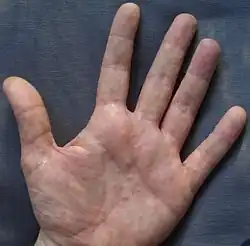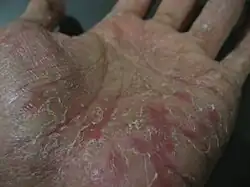Dyshidrosis
| Dyshidrosis | |
|---|---|
| Other names: Vesicular dermatitis of hands and feet,[1] acute vesiculobullous hand eczema,[2] dyshidrotic dermatitis,[3] cheiropompholyx,[4] dyshidrotic eczema,[4] pompholyx,[4] podopompholyx[4] | |
 | |
| The characteristic vesicles of dyshidrosis on a finger | |
| Pronunciation |
|
| Specialty | Dermatology |
| Symptoms | Itchy blisters on the palms of the hands and bottoms of the feet[6] |
| Complications | Skin thickening[7] |
| Usual onset | Often recurrent[8] |
| Duration | Heal over 3 weeks[7][8] |
| Causes | Unknown[8] |
| Diagnostic method | Based on symptoms[8] |
| Differential diagnosis | Pustular psoriasis, scabies[7] |
| Treatment | Avoiding triggers, barrier cream, steroid cream, antihistamines[6] |
| Frequency | ~1 in 2,000 (Sweden)[7] |
Dyshidrosis is a type of dermatitis that is characterized by itchy blisters on the palms of the hands and bottoms of the feet.[6][9] Blisters are generally one to two millimeters in size and heal over three weeks.[7][8] However, they often recur.[8] Redness is not usually present.[7] Repeated attacks may result in fissures and skin thickening.[7]
The cause is unknown.[8] Triggers may include allergens, physical or mental stress, frequent hand washing, or metals.[8] Diagnosis is typically based on what it looks like and the symptoms.[8] Allergy testing and culture may be done to rule out other problems.[8] Other conditions that produce similar symptoms include pustular psoriasis and scabies.[7]
Avoiding triggers may be useful as may a barrier cream.[7] Treatment is generally with steroid cream.[8] High strength steroid creams may be required for the first week or two.[7] Antihistamines may be used to help with the itch.[8] If this is not effective steroid pills, tacrolimus, or psoralen plus ultraviolet A (PUVA) may be tried.[7][8]
About 1 in 2,000 people are affected in Sweden.[7] Males and females appear to be affected equally.[7] It explains about one in five cases of hand dermatitis.[10] The first description was in 1873.[7] The name comes from the word "dyshidrotic", meaning "difficult sweating", as problems with sweating was once believed to be the cause.[7]
Signs and symptoms
Dyshidrosis has been described as having the following characteristics:
- Itchiness of the palms or soles, followed the a sudden development of intensely itchy small blisters on the sides of the fingers, the palms or the feet.[11]
- These blisters are often described as having a "tapioca pudding" appearance.[12]
- After a few weeks, the small blisters eventually disappear as the top layer of skin falls off.[7][13][14]
- These eruptions do not occur elsewhere on the body.[7]
- The eruptions may be symmetrical.[15]
 Advanced stage of dyshidrosis on the fingers
Advanced stage of dyshidrosis on the fingers Palmar dyshidrosis
Palmar dyshidrosis Advanced stage of palmar dyshidrosis on the palm showing cracked and peeling skin
Advanced stage of palmar dyshidrosis on the palm showing cracked and peeling skin Advanced stage of dyshidrosis on the foot.
Advanced stage of dyshidrosis on the foot. Rim of scale on the palmar surface of the thumb from a resolving dyshidrotic flare
Rim of scale on the palmar surface of the thumb from a resolving dyshidrotic flare
Causes
The exact causes of dyshidrosis are unknown. Food allergens may be involved in certain cases.[13] Cases studies have implicated a wide range of foods including tuna, tomato, pineapple, chocolate, coffee, and spices among others.[13] A number of studies have implicated balsam of Peru.[13] A 2013 study found that dyshydrosis on the hands increased among those allergic to house dust mites, following inhalation of house dust mite allergen.[16]
Id reaction and irritant contact dermatitis are possible causes.[10]
Diagnosis
Dyshidrosis is diagnosed based on symptoms, by gathering a patient's history and making observations.[8] Severity of symptoms can also be assessed using the dyshidrotic eczema area and severity index (DASI).[17] The DASI has been designed for clinical trials and is not typically used in practice.
Differential diagnosis
- Dermatitis herpetiformis – a similar condition caused by celiac and often mistaken for dyshidrosis.
- Epidermolysis bullosa – a genetic disorder that causes similar, albeit more severe, symptoms to those of dyshidrosis.
Treatment
There are many treatments available for dyshidrosis. However, few of them have been developed or tested specifically on the condition.
- Barriers to moisture and irritants, including barrier creams and gloves.[15]
- Topical steroids[18] – while useful, long-term use can result in skin-thinning.
- Potassium permanganate dilute solution soaks – also popular, and used to 'dry out' the vesicles,[19] and kill off superficial Staphylococcus aureus,[20] but it can also be very painful. Undiluted it may cause significant burning.[21]
- Dapsone (diamino-diphenyl sulfone), an antibacterial, has been recommended for the treatment of dyshidrosis in some chronic cases.[22]
- Antihistamines: Fexofenadine up to 180 mg per day.[23]
- Alitretinoin (9-cis-retinoic acid) has been approved for prescription in the UK. It is specifically used for chronic hand and foot eczema.[24][25][26] It is made by Basilea of Switzerland (BAL 4079).
- Systemic steroids can be taken by mouth to treat especially acute and severe cases of dyshidrosis.[15]
Epidemiology
About 1 in 2,000 people are affected in Sweden. Males and females appear to be affected equally.[7]
Synonyms
Dyshidrosis is also known as pompholyx,[1] a term originating from the Greek word for "bubble".[10]
References
- 1 2 "ICD-11 - ICD-11 for Mortality and Morbidity Statistics". icd.who.int. Archived from the original on 1 August 2018. Retrieved 26 September 2021.
- ↑ James, William; Berger, Timothy; Elston, Dirk (2005). Andrews' Diseases of the Skin: Clinical Dermatology (10th ed.). Saunders. ISBN 0-7216-2921-0.
- ↑ "Pompholyx". Patient. 2014-02-26. Archived from the original on 3 August 2016. Retrieved 11 August 2016.
- 1 2 3 4 Rapini, Ronald P.; Bolognia, Jean L.; Jorizzo, Joseph L. (2007). Dermatology: 2-Volume Set. St. Louis: Mosby. ISBN 978-1-4160-2999-1.
- ↑ "Dyshidrosis". Merriam-Webster Online. Merriam-Webster. 2014. Archived from the original on 15 April 2014. Retrieved 14 April 2014.
- 1 2 3 Lim, Henry W. (2020). "409. Eczemas, photodermatoses, papulomatoses, papulosquamous (including fungal) diseases, and figurate erythema: Eczema, dyshidrosis". In Goldman, Lee; Schafer, Andrew I. (eds.). Goldman-Cecil Medicine. Vol. 2 (26th ed.). Philadelphia: Elsevier. p. 2612. ISBN 978-0-323-53266-2. Archived from the original on 2023-04-28. Retrieved 2023-04-28.
- 1 2 3 4 5 6 7 8 9 10 11 12 13 14 15 16 17 18 Lofgren, SM; Warshaw, EM (December 2006). "Dyshidrosis: epidemiology, clinical characteristics, and therapy". Dermatitis : Contact, Atopic, Occupational, Drug. 17 (4): 165–81. doi:10.2310/6620.2006.05021. PMID 17150166.
- 1 2 3 4 5 6 7 8 9 10 11 12 13 14 Colomb-Lippa, D; Klingler, AM (July 2011). "Dyshidrosis". Journal of the American Academy of Physician Assistants. 24 (7): 54. PMID 21748961.
- ↑ "What Is Atopic Dermatitis? Fast Facts". NIAMS. November 2014. Archived from the original on 27 July 2016. Retrieved 11 August 2016.
- 1 2 3 Fitzpatrick, James (2016). "8". Dermatology Secrets Plus. Elsevier. pp. 70–81. ISBN 978-0-323-31029-1. Archived from the original on 2017-12-01. Retrieved 2017-11-27.
- ↑ Shelley, W. B. (1953-09-01). "Dysidrosis (pompholyx)". AMA Archives of Dermatology and Syphilology. 68 (3): 314–319. doi:10.1001/archderm.1953.01540090076008. ISSN 0096-5979. PMID 13079297.
- ↑ Bielan, Barbara (1996-04-01). "Dyshidrotic eczema". Dermatology Nursing. 8 (2). Archived from the original on 2017-04-02.
- 1 2 3 4 Veien, Niels K. (2009-07-01). "Acute and recurrent vesicular hand dermatitis". Dermatologic Clinics. 27 (3): 337–353, vii. doi:10.1016/j.det.2009.05.013. ISSN 1558-0520. PMID 19580928.
- ↑ Lofgren, Sabra M.; Warshaw, Erin M. (2006-12-01). "Dyshidrosis: epidemiology, clinical characteristics, and therapy". Dermatitis: Contact, Atopic, Occupational, Drug. 17 (4): 165–181. doi:10.2310/6620.2006.05021. ISSN 1710-3568. PMID 17150166.
- 1 2 3 Perry, Adam D.; Trafeli, John P. (2009-05-01). "Hand Dermatitis: Review of Etiology, Diagnosis, and Treatment". The Journal of the American Board of Family Medicine. 22 (3): 325–330. doi:10.3122/jabfm.2009.03.080118. ISSN 1557-2625. PMID 19429739.
- ↑ Schuttelaar ML, Coenraads PJ, Huizinga J, De Monchy JG, Vermeulen KM (2013). "Increase in vesicular hand eczema after house dust mite inhalation provocation: a double-blind, placebo-controlled, cross-over study" (PDF). Contact Dermatitis. 68 (2): 76–85. doi:10.1111/j.1600-0536.2012.02172.x. PMID 23046099. Archived (PDF) from the original on 2019-02-17. Retrieved 2019-02-05.
- ↑ Vocks, E.; Plötz, S. G.; Ring, J. (1999-01-01). "The Dyshidrotic Eczema Area and Severity Index – A score developed for the assessment of dyshidrotic eczema". Dermatology. 198 (3): 265–269. doi:10.1159/000018127. ISSN 1018-8665. PMID 10393450.
- ↑ "eMedicine – Dyshidrotic Eczema : Article by Camila K Janniger". Archived from the original on 2007-07-07. Retrieved 2007-07-10.
- ↑ BIRT AR (March 1964). "Drugs for Eczema of Children". Can Med Assoc J. 90 (11): 693–4. PMC 1922428. PMID 14127384.
- ↑ Stalder JF; Fleury M; Sourisse M; et al. (1992). "Comparative effects of two topical antiseptics (chlorhexidine vs KMn04) on bacterial skin flora in atopic dermatitis". Acta Derm Venereol Suppl (Stockh). 176: 132–4. PMID 1476027.
- ↑ Baron S, Moss C (February 2003). "Caustic burn caused by potassium permanganate". Arch. Dis. Child. 88 (2): 96. doi:10.1136/adc.88.2.96. PMC 1719457. PMID 12538301.
- ↑ "Vesicular hand dermatitis". Archived from the original on 2010-03-30. Retrieved 2010-04-07.
- ↑ Diepgen, Thomas L.; Agner, Tove; Aberer, Werner; Berth-Jones, John; Cambazard, Frédéric; Elsner, Peter; McFadden, John; Coenraads, Pieter Jan (2007-10-01). "Management of chronic hand eczema". Contact Dermatitis. 57 (4): 203–210. doi:10.1111/j.1600-0536.2007.01179.x. ISSN 1600-0536. PMID 17868211.
- ↑ Ruzicka T, Lynde CW, Jemec GB, Diepgen T, Berth-Jones J, Coenraads PJ, et al. (April 2008). "Efficacy and safety of oral alitretinoin (9-cis retinoic acid) in patients with severe chronic hand eczema refractory to topical corticosteroids: results of a randomized, double-blind, placebo-controlled, multicentre trial" (PDF). Br. J. Dermatol. 158 (4): 808–17. doi:10.1111/j.1365-2133.2008.08487.x. PMID 18294310. Archived (PDF) from the original on 2019-02-18. Retrieved 2019-02-05.
- ↑ Bollag W, Ott F (1999). "Successful treatment of chronic hand eczema with oral 9-cis-retinoic acid". Dermatology (Basel). 199 (4): 308–12. doi:10.1159/000018280. PMID 10640839.
- ↑ Ruzicka T, Larsen FG, Galewicz D, Horváth A, Coenraads PJ, Thestrup-Pedersen K, Ortonne JP, Zouboulis CC, Harsch M, Brown TC, Zultak M (December 2004). "Oral alitretinoin (9-cis-retinoic acid) therapy for chronic hand dermatitis in patients refractory to standard therapy: results of a randomized, double-blind, placebo-controlled, multicenter trial". Arch Dermatol. 140 (12): 1453–9. doi:10.1001/archderm.140.12.1453. PMID 15611422.
External links
| Classification | |
|---|---|
| External resources |
- Images of dyshidrotic eczema Archived 2016-11-17 at the Wayback Machine at Skinsight
- Pompholyx Archived 2016-07-31 at the Wayback Machine at DermNet NZ (New Zealand Dermatological Society Incorporated)